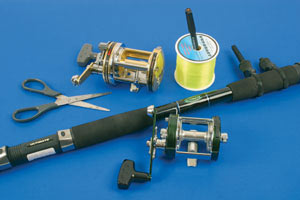Spool Balancing
I’m going to explain how I personally have my reels set up for fishing. I’m going to provide you with a simple guide to the way I approach and execute the task of setting a multiplier reel for general beach fishing. Last month we looked closely at how to tune the internal parts of the reel for maximum performance. However, there is still a little more work to be done and that involves correctly balancing the spool and laying the line evenly onto the spool.
There can be nothing more satisfying than to know that no matter what conditions you decide to fish in, your multiplier will behave and cause you no trouble. However, it is all too common for an angler to have problems with his reel, resulting in bird’s-nests, loss of line and worst of all, less fishing time. These are the most common reasons that many anglers steer clear of these reels altogether. As a rule, much of the problem is due to incorrect tuning with oils and brake blocks, but there is another factor that follows on from the initial setting up of a reel and this is spool balancing.
It is in fact hard to control a tool of any sort when it rattles and wobbles about, because it becomes erratic and provides an inconsistent performance. So for these reasons, it is necessary to have a correctly balanced spool for the best results. Believe it or not, there is a right and wrong way to put line onto a spool. So it is always wise to take the time to perform this task, because a well-balanced spool runs quietly, smoothly and more efficiently. To begin with, it should be explained why it is necessary to load a multiplier spool correctly, and to help you understand, here are a couple of the most frequently asked questions about the subject.
Q: My reel is noisy and sounds like a bag of bolts when I cast, why is this?
A. The straightforward answer is that the particular way the first 50 metres of line is put onto the spool can dramatically affect the way a spool becomes balanced. It is virtually the same deal with wheel balancing on a car; if they are not balanced, the whole car will rattle.
Q. Sometimes the line on my reel blows up for no apparent reason during a cast, why?
A. A badly balanced spool does not run smoothly and can lead to the reel spool surging during the cast and any sudden change of spool speed in a cast can cause a bird’s-nest. On occasions, when a reel is extremely out of balance, the spool can vibrate so much that it can rub against the inner of the cage. This will certainly make a spool run inconsistently, resulting in endless trouble.
Q. My reel is noisy when I cast it, how do I make it quiet?
A. It is likely that your spool was incorrectly balanced when you first put line on it, which can lead to the bearings becoming worn out. The simple solution here is to follow my tips on spool balancing, but if that doesn’t work then you may have to change the bearings.
Now you should have a reel that is ready to be spooled up with fresh line. I am using an Abu Mag Elite for this purpose, but my procedure is the same for all types of casting multiplier reels. However, this is also the time to exercise the most patience of all because balancing the spool can make a saint swear at times. The best method is by firstly mounting the reel onto a rod butt and run the line through a ring directly from the new spool of line. If possible, use a spooling station or get someone to hold the spool of line for you as you wind it onto the reel.
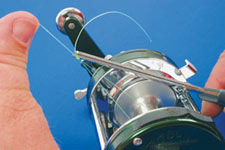 |
| 1 – Start by attaching the line to the spool by using a uni or grinner knot. Make the knot, tighten it and then trim the tag before pulling it down to the spool. You will find that the tag is easier to cut when away from the spool. |
|
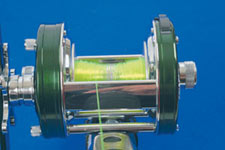 |
| 2 – There are now two effective ways to lay the first 30 metres of line, that actually ‘balances’ the spool. The first method is by humping the line on either side of the spool and then forming a barrel in the middle. Ensure that the left and right humps are similar in size and pattern and not one bigger than the other. |
|
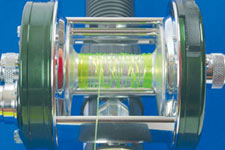 |
| 3 – The other way to lay the line is by abruptly moving the line from side to side in an irregular fashion. The reason we don’t lay it in a cotton spool style is because line diameters are generally inconsistent and therefore heavier in certain places, which leads to an unbalanced spool. |
|
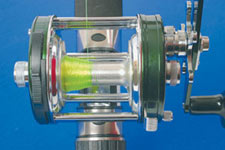 |
| 4 – I have chosen to spool The Mag Elite with the humps either side and then barrel the line in the middle. It doesn’t matter which side you start the process, but I usually start at the left then move across the spool when the first hump is established. |
|
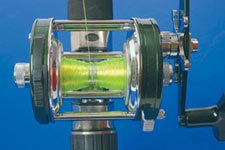 |
| 5 – With a sufficient hump of line on the left-hand side, I then sharply push the line across to the right-hand side of the spool and repeat the process. This will leave two humps, like this, on either side of the spool. |
|
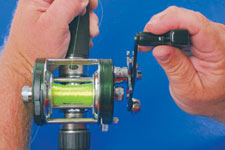 |
| 6 – Now we have to fill the middle of the spool. I do this by building another hump. But as the hump grows it also needs to be widened so that it will reach the same level as the humps on both the right and left-hand sides of the spool. |
|
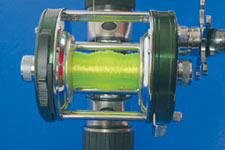 |
| 7 – The spool should now start to look something like this – notice the slight hump or barrel shape in the middle of the spool. It is now ready to fill the spool close to the rim. |
|
 |
| 8 – To finish it off, start passing the line from one side of the spool to the other, but this time you must ensure that the coils of line are wound on close together like a spool of cotton. This will ensure that the line leaves the spool evenly and unhindered when casting. |
|
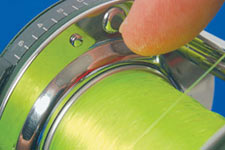 |
| 9 – The amount of line that you have on the reel will also play an important part in the reel’s performance and overfilling the spool can cause overruns. We recommend that you leave about 1mm from the spool rim for the optimum performance. |
|
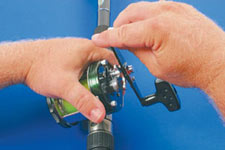 |
| 10 – To get an idea of how the reel is running, knot the line on the spool and then spin the spool as fast as possible. To do this you will need to keep your thumb over the spool-release button and as you spin the reel handle, push the button in. Any noise will indicate if the spool is out of balance. |
|
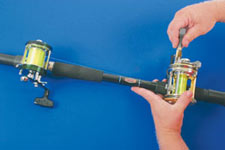 |
| 11 – TOP TIP: If the reel is still noisy it will be necessary to repeat the spooling process to correct it. The easiest way to do this is by winding all of the line onto a second reel and then repeating the balancing process. |
|
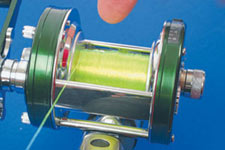 |
|
12 – TOP TIP: When replacing line onto a perfectly balanced spool, DO NOT remove all of the line. Only take the line down to the end of the balancing process and then add the new line. This will ensure that the reel always performs to its maximum.
|
|
Total Sea Fishing


